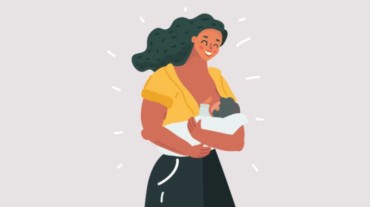
As new moms, women get a considerable amount of information and advice on what is right or wrong for our baby. But when it comes to breastfeeding the baby, not many of us are able to decide if the baby is getting satisfied with our breast milk. All the mothers have a universal query, “Is my baby getting enough milk?” This happens when mothers don’t understand why the baby keeps clinging onto the breast and why they sometimes continue to cry even after the feed.
We need to understand that nothing in this world can measure the quantity of milk present in the mother’s breast. The amount of milk that you express via any pump or any other method is not the same amount that your baby gets when he or she suckles directly on the breast. The breast produces milk according to the demand of the baby. If the baby is always clinging on the breast, this doesn’t indicate lesser milk flow or supply.

Initially for the first two three days, breasts are soft. But it does not indicate that they don’t have milk. If the baby wakes up frequently or takes top feed even after breastfeeding for a while, it is not a sign of low supply. If your breasts do not leak doesn’t mean you have no or low milk supply. Irregular feeding or frequent feeding by the baby or unsettled evenings are again not a sign of low milk supply.
There are two main indicators:
An 8-10 percent weight loss after birth is normal and the baby then regains the weight by 10 to 14 days (some babies may even take longer). If the baby is gaining sufficient weight on mother’s milk then baby is getting enough milk. One should evaluate the growth using WHO baby weight gain growth curve (different for boys and girls) and can be downloaded from their website. If the curve plotted is consistently up and not kinking (dropping down) means your baby is gaining enough weight and hence you are producing enough milk.
For the first five days of a baby’s life, the baby should pass urine according to the day of life. Day 1 – a minimum of 1 wet nappy, Day 2 – a minimum 2 nappies, so on and so forth, till Day 5, after which if the baby is wetting six nappies in one day, it means he is being well fed. This means 2 to 3 diapers in 24 hours.
1. Baby is active and meeting developmental milestones
Birth to 1 year:
* Able to drink from a cup
* Able to sit alone, without support
* Babbles
* Displays social smile
* Gets first tooth
* Plays peek-a-boo
* Pulls self to standing position
* Rolls over by self
* Says mama and dada, using terms appropriately
* Understands “NO” and will stop activity in response
* Walks while holding on to furniture or other support
Also Read: What’s the difference between breast milk and formula? Hear it from an expert!
Select Topics of your interest and let us customize your feed.
PERSONALISE NOW
2. Long pauses while suckling (observe the babies’ chin movements)
3. In the initial 3-4 days, the stool colour is usually black or green and after that it normalizes to mustard yellow. However, poop count is not an indicator as babies may poop frequently in a day (eight times in a day) or maybe once in 8 to 10 days.
Also Read: Breastfeeding is exhausting, but worth it, says actress Evelyn Sharma
Babies who are at the breast for longer durations are so because of the comfort and warmth they receive when they are on the chest of the mothers as the fluid released from the breast acts as olfactory guide for the babies to suckle. Breasts are baby’s habitat, so it is natural for them to be on the breast most of the times whether they are feeding or not as breasts are really soothing for the babies.